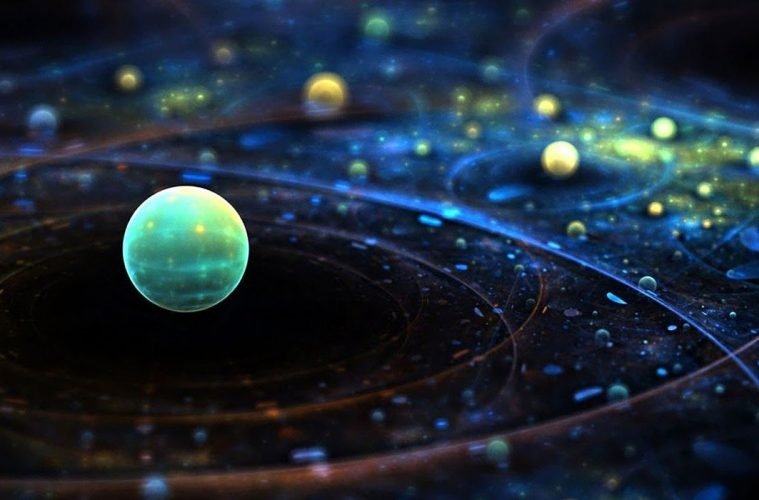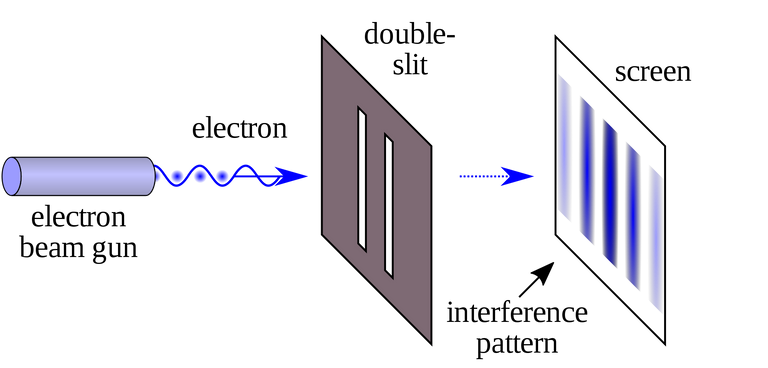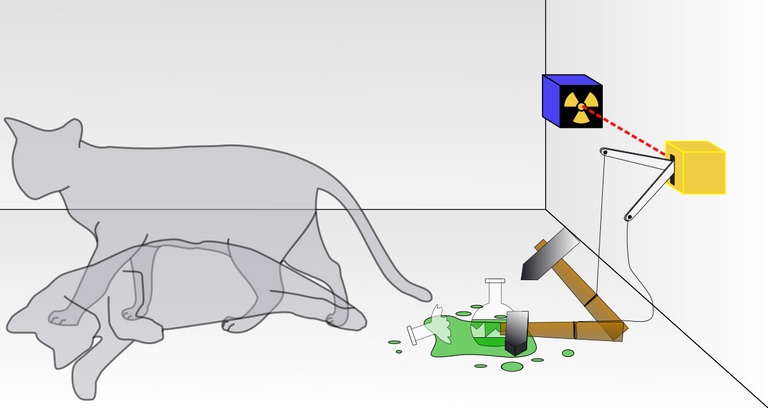
The theory of quanta is similar to other victories in science; for some months you smile at it, and then for years you weep.
—Hendrick Kramers
Quantum physics was first introduced by Max Planck’s “quanta” solution to the blackbody radiation problem and further validated by Einstein’s solution to the photoelectric effect. Since then, the discipline has changed dramatically due to a variety of illuminating experiments and discoveries. Perhaps the most interesting of these developments was the famous “double-slit” experiment and its problematic implications.

(Image courtesy of wikipedia https://en.wikipedia.org/wiki/Double-slit_experiment)
Thomas Young performed a double-slit experiment as early as 1801. He found that by shining light through two slits at once, a wave interference pattern was produced in the light and shadow on the wall behind the slits. Young used this discovery as evidence to support the wave theory of light. In 1927 a similar experiment was performed by Davisson and Germer, but instead of shining light they chose to fire individual electrons at the slits one after another. After passing through the slits the electrons would strike a crystalline nickel target, which would record the impact with the appearance of a tiny, shining dot. It was suspected that sum of the impacts would amount to two clusters of dots (one cluster behind each slit), but strangely the dots gradually formed the same wave interference pattern observed in the Young experiment. The electrons passed through only one slit or the other and appeared to strike the target as point particles, yet they somehow were interfering with themselves to produce a wave interference pattern. Subsequent experiments discovered an equally strange fact: placing a particle detector in front of one of the slits, so that one knows which slit the particle has passed through, caused the wave interference pattern to disappear. When we know which slit the particle is passing through, the impacts form two distinct clusters just as we would expect with a classically behaving object.
These experimental results led directly to the notion that, before we detect them at a specific location, particles do not have definite positions. A “probability wave” determines the positions where the particle is most likely to be found, and we consider the particle’s present state a superposition of all of these possible positions until the moment when the particle is detected and the probabilistic wave function “collapses” into a single position. This “probability wave” is not merely an abstract notion, however. It is considered real and the source of the wave distribution of particle impacts, but the problem is that we have no way of conceiving of the physical embodiment of the wave function. We have no way of understanding what the “probability wave” actually signifies except for the observable results it produces. The mathematical framework of quantum theory is universally accepted as an accurate description of all atomic phenomena, but in more than eighty years physicists have not been able to reach any consensus regarding the metaphysical basis of its most crucial facet, the probability wave.
Consider a slot machine. It is fair to say that my success on any given slot machine can be modeled by probabilistic mathematics. However, it is not fair to say that my probabilistic mathematics may influence the outcomes produced by the machine. If I were to understand all of the inner workings of the machine or the algorithm employed by its computer, then I would also understand its deterministic nature and be able to predict with certainty all subsequent outcomes. In all of nature except for quantum physics, it is generally understood that deterministic laws underpin seemingly probabilistic outcomes. In the quantum world, however, physicists sincerely believe that the laws of physics are indeterministic and that particle positions are determined on a fundamental level by probability equations.
This unsettling notion is what led Einstein to deny that God “plays dice with the universe.” Edwin Schrodinger, who wrote the most essential equation of quantum probabilistic mechanics, similarly refused to accept the philosophical stance of his fellow quantum physicists. He invented a clever thought experiment to criticize the popular interpretation of quantum probability, tying the macro world of common objects to the indeterministic micro world of quanta. Now commonly referred to as “Schrodinger’s Cat,” the parable asks us to imagine a peculiar and comically inhumane experiment involving a box, a cat, a vial of cyanide, a hammer, a radiation sensor, and a small quantity of a radioactive isotope. When the isotope decays, the sensor detects the emitted particle and triggers the hammer, which strikes the vial of cyanide, releases the poison, and kills the unfortunate cat. All of this takes place within the obfuscated confines of the box, so that the experimenter cannot know the state of the cat until they open the box and make a direct observation. Before observation, we say that the quantum state of the radioactive isotope is in a superimposed state defined by its probability wave; it is both decayed and undecayed simultaneously. The circumstances of the experiment force us to extrapolate the superimposed state of the micro world upward to the macro world of the hammer, vial, and feline. If the isotope is both decayed and undecayed, then the cat must be simultaneously dead and alive. Upon opening the box, the experimenter’s observation collapses the cat wave function, ends the superposition, and causes the cat to assume a definite state of either life or death.

(Image courtesy of Wikipedia https://en.wikipedia.org/wiki/Schr%C3%B6dinger%27s_cat)
In Schrodinger’s opinion, the notion of a superposition of cat states was absurd.
The cat is either alive or dead, not both, and our discovering its state can have no influence on the predetermined fact of its life or death. Not everyone agreed with him, however. The spooky behavior of the double slit experiment suggested to Schrodinger’s contemporaries that particle positions are truly random and that the observer does play a direct role in creating a definite particle position, collapsing the wave function through the act of observation.
The entire notion of physical laws presupposes a determinate universe, and if particle positions are genuinely subject to probability we must conclude that either some God has written quantum mechanical equations directly into the code of the universe or, as in a slot machine, that there is a more fundamental, deterministic process at work which we do not have access to. Personally, I am inclined to agree with Schrodinger and believe that there is more to the situation than meets the eye.
There has only been one solution posed that can come anywhere close to alleviating the metaphysical woes of quantum physics: Hugh Everett’s relative-state theory. Everett proposed that the probability wave and superposition of particles is real and that the subjectivity of an observer’s perspective produces the illusion of wave collapse. In his treatment, all quanta are in a constant state of hemorrhaging or “splitting,” and this bifurcation is translated to the macro scale of the observer. In what we might call parallel universes, every possible particle location is realized as a separate branch spreading from the origin particle of the previous moment. In our perception, a particle will appear at a single location, but meanwhile other branches of the same particle have appeared at different relative locations relative to the universe of particles that have branched along with it. Our observations do not “collapse” the wave function in any meaningful way; they merely reveal to us which branch of the universal wave function we exist in. In this paradigm we are justified in saying that the outcome is determined mechanically but observed probabilistically-- the deterministic outcome will be unique for each of the parallel versions of the observer, and these parallel observers will be inherently helpless to explain why they saw one of the possible outcomes and not another.
Let’s now apply this concept to the experiments we addressed earlier. In the Schrodinger’s cat scenario, we find that the cat really is alive and dead at the same time, just not in the same branch of the universe. When the experimenter opens the box and finds a living cat, they can rest assured that this cat has been alive and irritated for the entire duration of the experiment. In other branches, however, the isotope may have decayed and brought about the demise of the cat. Both branches are equally valid, and this “superposition” of states is really just the existence of independent alternatives. Returning now to the double-slit experiment, we must find a way to explain both the presence of the wave interference pattern as well as its disappearance when we monitor the energy passing through the slits. As of yet, no satisfactory explanation has been provided to convincingly explain either phenomena.
If all of this “many-worlds” stuff seems a little far-fetched, that’s okay. I do not present this concept in order to convince you of its utility so much as to convince you that quantum physics is incomplete. Our best attempt at explaining the effects of quantum physics on a metaphysical level requires us to rely upon a logical abstraction which is itself incomplete and unverifiable. While quantum physics has been thoroughly confirmed and validated, we must acknowledge that we are still miles away from a complete and unified theory. We must save the back-patting and self congratulations until the day when we can actually explain what it is, exactly, that we have found.
(cover photo courtesy of Collective Evolution http://www.collective-evolution.com/2016/07/31/how-quantum-mechanics-is-changing-everything-we-know-about-our-lives/)
I read something on quantum computing a while back where the processor (if you can call it that) actually sends calculations to (possibly) another parallel to be solved. All of the exact terms escape me now but it was quite amazing, as are the concepts you set forth.
Me gusta tu teoría!....
Es cierta!
Felicidades
Este es un teme muy complejo y de expertos en la física cuántica. hay cosas inexplicables y complejas a simple vista, pero tiene su basamento científico. Gracias por compartir estos conocimientos. Buen Post.
Hi ! you have been promoted in our blog which is interested in good content on steemit! you can check this on the link below!
https://steemit.com/steemit/@trust.science/support-beginners-date-21-5-2018-do-the-promotion-for-good-content-on-steemit